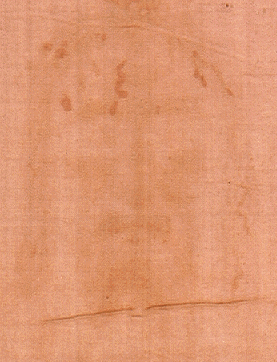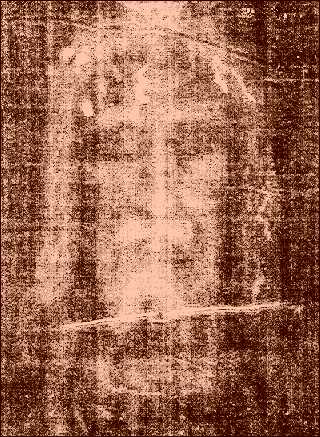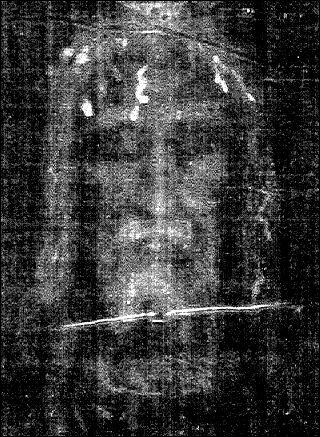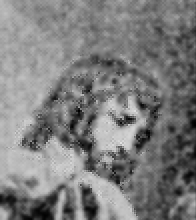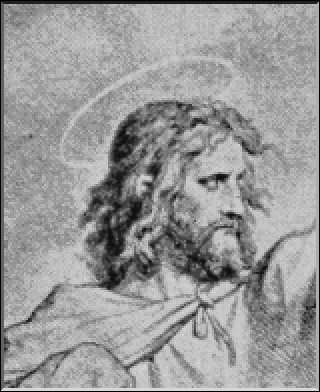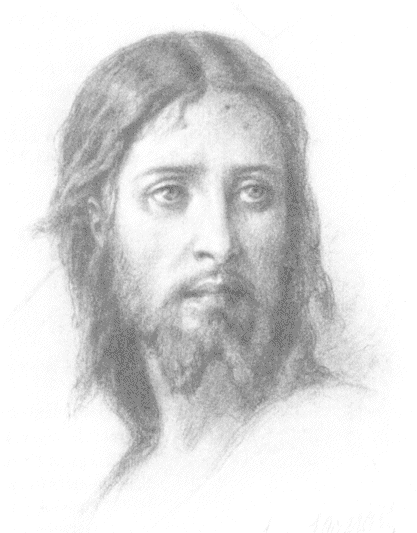And just a few comments on all this, to conclude:
Not to go into all the arguments, but it seems to me that
the shroud might have had some more easily verifiable history,
prior to the late Middle Ages, were it genuine. The dark ages
had ended centuries, before. Yet, Cruz seems to think it not
so difficult as, not surprizingly, the debunker would have it,
to trace the shroud to the east as the Mandylion.
There
is that odd difference in 'exposure' beyond what appears
to be a straight fold in the linen just to either side
of the face; giving sort of a highlighted vertical sliver
of the face. It suggests the handkerchief, noted in Scripture,
perhaps used to bind the jaw and running up over the cheeks.
But it would depend on the method used to fold the shroud
in those times.
It's also the case that I haven't heard of other
shrouds showing such images, even if artificially produced
for posterity by loved ones. And there's the odd fact about
this that the detail does not really appear, except as a
negative, as it were, of the shroud image. It suggests
there was another way to view the shroud in recent antiquity;
else, why create it as a fake in such a way? Perhaps the
skeptic would reply it is merely serendipity that whatever
technic was used, yields such detail when manipulated by
spectrally sensitive photo equipment or even simple digital
image processing software, of the present day.
The thing is, it isn't simply a matter of seeing
Our Lord however He wishes to appear.
It may be Ruebens, or someone else, somehow had a better
take on what Our Lord, Jesus Christ, really looked like.
Perhaps, instead, Hofmann was onto something, or whoever
drew that more recent sketch; both of which more resemble
the image on the shroud.
But if the shroud is, in fact, the Holy Shroud, the one
likely carried away by the Apostles,
only rarely to be opened, stored away and forgotten through
Roman persecution to emerge in Byzantium as the Mandylion,
and only later to be discovered at the close of the Middle
Ages in what amounts to an estate sale, then even at that we
should consider that image as that of Our
Lord, and not merely one of many possibilities.
It deserves, then, to be considered and held in just
that highest esteem (as frankly, it is, even now - without
our really knowing for sure).
The same holds for the veil of Seraphia/'Veronica',
currently in St. Peter's, should it be verified as authentic.
And there is the question, of course, that if the shroud
of Turin is the Mandylion, why is there any confusion
over this - as those from the east, those who had seen it,
could verify it was at least one and the same. Surely the
battle lines were sufficiently porous that those from the
east could visit in the west.
However, since we _don't_ know, since it forces
us to continue to rely on faith since we don't, it
suggests that we can see God in various guises,
in reaching out to various people; however they look.
It suggests we ought not be disappointed not only if
the shroud, ultimately, turns out to be a medieval fake,
but if Our Lord appeared then, and appears now, otherwise
than as suggested
by the rather consistent images above.
That is, the images of Our Blessed Mother vary, somewhat,
just by comparison, from Guadalupe to Jasna Gora.
Perhaps the images we have of Our Lord, Jesus Christ,
from various hands, and on the shroud of Turin, are
not entirely how He appeared.
And we might find many people similar in appearance,
similar to Mary, rather regal looking - with the eyes,
the long nose, the
rather tall, oval face, and the like.
Beyond that, Our Lord may have had some other unique
features, so that He did not, really, at the time,
look so much as He has been depicted, since, by
certain artists, and not others.
And yet my opinion, my gut, perhaps my conscience, here,
tells me this is not a fake, but is the self-same
shroud spoken of in Scripture, the Holy Shroud,
that the holy women saw, but didn't retrieve,
laying in the vacant tomb, next to the face cloth
all neatly folded, pointed to
by the angel on site, we might say.
But I can't say it for a fact.
There are so many problems, unanswered questions,
about it, even for all the things that would be
consistent were it the genuine Holy Shroud.
Perhaps I'm led to believe this is the
face of God, of Jesus Christ, Himself, because
simply of the expression we can now see in the
various enhanced photos.
Where one can just make out the eyes, downcast and
almost entirely closed, perhaps swollen from beating, likely soaked
with the blood obviously still flowing down, they
suggest not bitterness, nor smugness nor haughtiness,
but fatigue and exhaustion.
They even show sadness, not the traces of anger.
It appears to be the face of a man utterly spent,
to the very last.
The lips are parted, as if still making that final
Mysterious effort to cast His soul out of His Body,
as Our Lord shouted out, at the last, on The Cross.
If it is the face of Christ, it's the countenance
of God giving every last little bit for our sake;
holding nothing back, without bitterness; literally
on a mission of Redemption, of love, and with nothing
else in mind.
For Him to have been treated as He was . . .
and yet it had to be done, the prophecy had to come
true, and He did not offer the words that would
have spared Him, either before the high priests or
before Pilate, who would have let Him go (but not
simply because He was obviously innocent).
It recalls His words to His parents in the 2nd Temple,
at the age of twelve. I think we see evidence of
that business of His Father in the face of the shroud,
as He was tortured and gave up His last, so many years
later, on a hill just within site of that very same
Temple in which He had later taught, again, as an adult.
|
![(distorted and enhanced image from unretouched photo of Shroud of Turin [if you aren't loading images, you really should this one])](./img/pics/Face_X.jpg)
